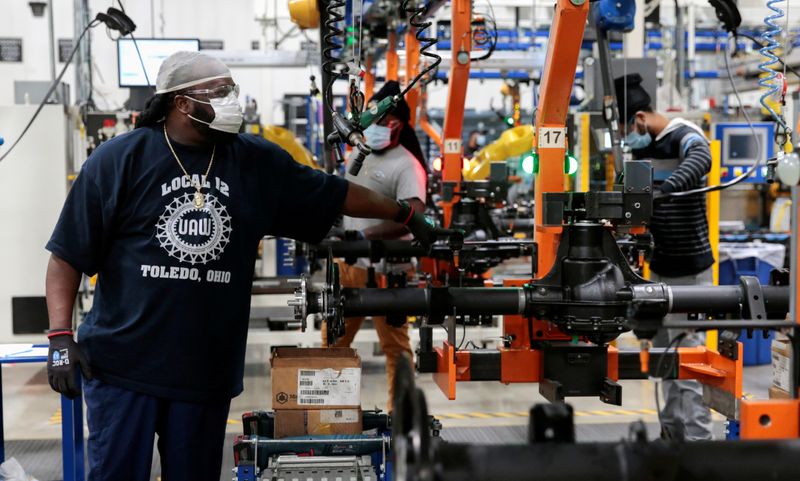By Lucia Mutikani
WASHINGTON (Reuters) -U.S. manufacturing activity slowed in November, with new orders retreating from their highest level in nearly 17 years, as a resurgence in COVID-19 cases across the nation kept workers at home and factories temporarily shut down to sanitize facilities.
The Institute for Supply Management (ISM) on Tuesday warned that absenteeism at factories and their suppliers as well as difficulties in returning and hiring workers would continue to "dampen" manufacturing until the coronavirus crisis ended.
The softening in factory activity supports expectations for a sharp deceleration in economic growth in the fourth quarter amid the raging pandemic and end of fiscal stimulus.
Treasury Secretary Steven Mnuchin and Federal Reserve Chair Jerome Powell on Tuesday urged Congress to provide more help for small businesses. A bipartisan group of lawmakers proposed a new $908 billion emergency relief package for small businesses and millions of unemployed Americans.
"The feared economic slowdown is starting, but it is pretty slow off the blocks," said Joel Naroff, chief economist at Naroff Economics in Holland, Pennsylvania.
The ISM's index of national factory activity dropped to a reading of 57.5 last month from 59.3 in October, which had been the highest since November 2018. A reading above 50 indicates expansion in manufacturing, which accounts for 11.3% of the U.S. economy. Economists polled by Reuters had forecast the index would slip to 58 in November.
Sixteen manufacturing industries, including wood products, machinery and transportation equipment, reported growth last month. Petroleum and coal products, as well as printing and related support activities industries, contracted.
The United States is in the grip of a fresh wave of COVID-19 infections, with 4.2 million new cases and over 35,000 coronavirus-related deaths reported in November, according to a Reuters tally of official data. The virus is likely to disrupt production at factories. Manufacturing output is still about 5% below its pre-pandemic level, according to the Fed.
More than $3 trillion in government COVID-19 relief has run out. The fiscal stimulus helped millions of unemployed Americans cover daily expenses and companies keep workers on payrolls, leading to record economic growth in the third quarter.
Slowing manufacturing activity followed on the heels of data last week showing consumer spending cooling in October.
The economy grew at a historic 33.1% annualized rate in the third quarter after shrinking at a 31.4% rate in the April-June period, the deepest since the government started keeping records in 1947. Growth estimates for the fourth quarter are mostly below a 5% rate. Exploding COVID-19 infections and lack of additional stimulus have left some economists anticipating a contraction in the first quarter of 2021.
A second report from the Commerce Department on Tuesday showed a solid increase in construction spending in October, but outlays in September actually declined instead of rising modestly as was previously estimated.
Stocks on Wall Street rose, with the S&P 500 index and the Nasdaq hitting record highs on hopes that a COVID-19 vaccine would be available soon. The dollar fell to a 2-1/2-year low against a basket of currencies. U.S. Treasury prices were lower.
MIXED VIEWS
Manufacturers last month offered mixed assessments of business conditions. Transportation equipment makers said the flare-up in COVID-19 cases was straining suppliers, with labor the main issue, impacting production.
In the food industry, factories were "sending employees home for 14 days to quarantine," and "had to shut down production lines due to lack of staffing." This led to "much higher than normal" production costs, suggesting consumers could soon be paying more at the supermarket at a time when about 13.6 million Americans are due to lose government-funded unemployment benefits a day after Christmas.
But fabricated metal producers reported strong business and said they expected demand to continue growing in 2021. Machinery manufacturers were also upbeat, though they said the coronavirus remained a concern.
ISM's forward-looking new orders sub-index fell to a reading of 65.1 in November from 67.9 in October, which was the highest reading since January 2004. Manufacturing employment contracted after expanding in October for the first time since July 2019.
ISM's manufacturing employment gauge dropped to a reading of 48.4 from 53.2 in October. That likely reflects the absenteeism due to the coronavirus as well as layoffs as demand softens. It fits in with economists' expectations that job growth slowed further in November. Manufacturing accounts for more than 10% of private payroll employment.
"Today's news of layoffs in the sector, either planned or unplanned, is a worrisome sign that shows there is not a clear path to winning here for the economic outlook as 2021 approaches," Chris Rupkey, chief economist at MUFG in New York.
According to an early Reuters survey of economists, nonfarm payrolls probably increased by 495,000 jobs last month after rising by 638,000 in October. Employment growth has cooled from a record 4.781 million new jobs in June.

About 12.1 million of the 22.2 million jobs lost in March and April have been recovered. The government is scheduled to publish November's employment report on Friday.